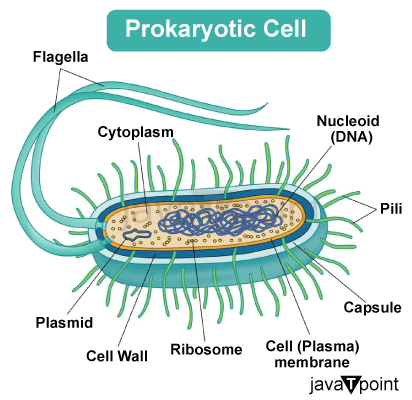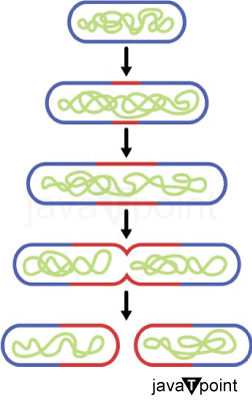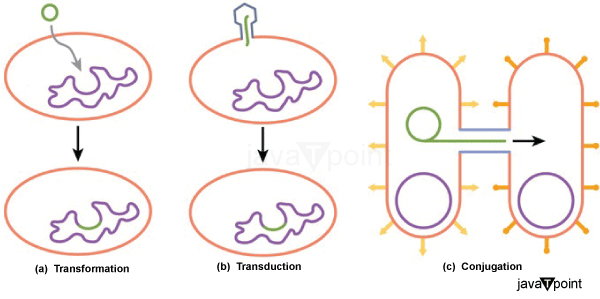Prokaryotic Cells
What are Prokaryotic Cells?
Prokaryotic cells are an essential and distinctive class of cellular organisms that are distinguished by specific structural and functional characteristics. These cells are distinct from eukaryotic cells, which have membrane-bound organelles such as a well-defined nucleus and other organelles. Since these cells lack a true nucleus, the term "prokaryote" is derived from the Greek words "pro" for before and "karyon" for nucleus.
Structure of Prokaryotic Cells
Prokaryotic cells have a structure that is comparatively simple when viewed alongside eukaryotic cells, but it is precisely designed to support their vital functions. There are several essential elements that can be used to describe their structure:

- Cell Wall: A rigid cell wall that protects and supports many prokaryotic cells and aids in maintaining their shape is present. Peptidoglycan, a special polymer made of sugars and amino acids, makes up the cell wall. There are two distinct layers in some prokaryotes, such as Gram-negative bacteria: an inner coating of peptidoglycan and an exterior membrane.
- Plasma Membrane: The cytoplasm is encircled by the plasma membrane, also referred to as the cell membrane, which divides the interior of the cell from its surroundings. It is made up of a protein- and lipid-embedded lipid bilayer. The internal environment of the cell is governed by the plasma membrane, which also controls the flow of molecules into and out of the cell.
- Cytoplasm: The interior of the cell is filled with cytoplasm, which resembles gel. It contains a variety of cellular elements, such as ribosomes, the nucleoid, and other metabolic machinery. Numerous biochemical processes, such as the processing of nutrients and the production of energy, occur in the cytoplasm.
- Nucleoid: Prokaryotic cells lack a true nucleus, in contrast to eukaryotic cells. Instead, a single circular DNA molecule makes up the genetic material, which is found in a region known as the nucleoid. The instructions for the cell's development, growth, and operation are encoded in its DNA.
- Ribosomes: Prokaryotic cells contain ribosomes, which are in charge of protein synthesis. The genetic code of DNA must be translated into functional proteins by these ribosomes, which are smaller than those found in eukaryotic cells.
- Plasmids: Small circular DNA molecules called plasmids, which exist outside the main chromosome, may be present in some prokaryotic cells. Plasmids frequently contain accessory genes that give the cell particular advantages, such as resistance to antibiotics or the capacity to metabolise novel substances.
- Flagella: Flagella are long whip-like structures that extend from the surface of many prokaryotic cells. Flagella, which rotate like a propeller, allow the cell to move. Ions moving across the plasma membrane frequently cause the movement.
- Pili: Some prokaryotic cells have short, hair-like projections called pili on their surfaces. They perform a variety of tasks, such as surface attachment and the exchange of genetic material during a process known as conjugation.
- Capsule and Slime Layer: A protective layer outside of the cell wall called a capsule or slime layer surrounds some prokaryotic cells. This layer can aid in the cell's ability to stick to surfaces, evade the immune system, and offer defence against unfavourable environmental factors.
- Inclusions: Additionally, inclusions?structures that store substances like nutrients and metabolic waste?can be found in prokaryotic cells. These inclusions can change based on the metabolic requirements of the cell and the surroundings it lives in.
Types of Prokaryotic Cells
The simplest and oldest types of life, prokaryotic cells are extremely diverse, capable of adapting to different environments, and possess a remarkable range of metabolic capabilities. Bacteria and Archaea are two separate domains that make up the majority of this diversity. The distinct prokaryotic cell types found in each domain exhibit various structural traits, biochemical functions, and ecological roles.
Bacteria
Bacteria are pervasive microorganisms that can be found in almost all habitats on Earth. They are essential for symbiotic relationships, nutrient cycling, and human health. Bacteria are frequently categorised according to how they look, how they are arranged, and how they stain things.
- Cocci (Spherical Bacteria): Cocci are spherical-shaped bacteria. They can appear alone, in pairs (diplococci), chains (streptococci), clusters (staphylococci), groups of four (tetrads), or all by themselves. Streptococcus, Staphylococcus, and Neisseria are a few notable cocci.
- Bacilli (Rod-Shaped Bacteria): Bacilli are cylindrical or rod-shaped, elongated bacteria. They can form chains or live alone. Escherichia coli (E. coli), Bacillus subtilis, and Lactobacillus are a few examples of bacilli.
- Spirilla (Spiral-Shaped Bacteria): Spirilla are bacteria with spiral or helical shapes and flexible or rigid structures. The spirilla Campylobacter and Helicobacter pylori are two well-known examples.
- Spirochetes: The distinctive group of spiral bacteria known as spirochetes is distinguished by its malleable, corkscrew-like structure. They include pathogens like Borrelia burgdorferi, which causes Lyme disease, and Treponema pallidum, which causes syphilis.
- Filamentous Bacteria: The decomposition and cycling of nutrients are two processes in which these bacteria frequently participate. They also form long, filamentous structures. Examples of genera include Cyanobacteria (also referred to as blue-green algae) and Streptomyces.
- Endospore-Forming Bacteria: Some bacteria have the capacity to produce endospores, dormant structures with high resistance that enable them to endure harsh environments. Bacillus and Clostridium are two examples of bacteria that can produce endospores.
- Phototrophic Bacteria: For photosynthesis, phototrophic bacteria use light energy. Cyanobacteria are well-known phototrophs that produce oxygen through photosynthesis and are frequently found in aquatic environments.
Archaea
A unique class of prokaryotic cells that live in a variety of environments, including those with extreme heat, acidity, and salinity. They were formerly grouped with bacteria, but genetic and biochemical studies have since uncovered their distinctive traits.
- Methanogens: In anaerobic environments, methanogenic archaea are essential for the cycling of carbon and energy. As a byproduct of their metabolism, they release methane gas. Methanogens can be found in wetlands, marshes, and animal digestive tracts, among other places.
- Halophiles: In extremely salty environments like salt flats and salt mines, halophilic archaea thrive. They have evolved to live in environments with salt concentrations that are much higher than what the majority of other organisms can tolerate.
- Thermophiles: Archaea that prefer high temperatures, such as those found in hydrothermal vents, hot springs, and deep-sea thermal vents, are known as thermophiles. They can survive in conditions that would be fatal to the majority of other organisms.
- Hyperthermophiles: A subset of thermophiles known as hyperthermophiles can endure temperatures up to and frequently beyond 80 °C (176 °F). They can be found in places like geysers and hydrothermal vents.
- Acidophiles: In extremely acidic environments like hot springs and acid mine drainage, these bacteria thrive. They have been able to adapt to low pH environments.
- Alkaliphiles: These are archaea, which means they prefer alkaline conditions with high pH levels. They can be found in areas like alkaline soils and soda lakes.
- Methanotrophs: Methanotrophic archaea can use methane as a source of carbon and energy. They contribute to the decrease in methane emissions from wetlands and rice paddies, for example.
Reproduction in Prokaryotes
Reproduction in prokaryotes is a fascinating and diverse process that allows these simple yet highly adaptable organisms to proliferate and colonize a wide range of environments. Prokaryotic reproduction primarily occurs through two main mechanisms, binary fission and horizontal gene transfer. These processes contribute to the rapid growth and genetic diversity of prokaryotic populations.
Binary Fission
The most typical form of prokaryotic reproduction, particularly in bacteria, is binary fission. A single parent cell divides into two genetically identical daughter cells using this quick and easy process. There are several crucial steps in the process:

- DNA duplication: The circular DNA molecule is replicated in the prokaryotic cell's nucleoid region as the first step in binary fission. As a result, the genetic material is duplicated twice and attached to the cell membrane.
- Cell Elongation: The cell lengthens and expands as the DNA replicates. In order to prepare the cell for division, both the cell wall and membrane grow.
- Cell division: At the midpoint, the cell membrane and cell wall start to contract, creating a structure called the "dividing septum." The parent cell eventually splits into two daughter cells as a result of this septum.
- Complete Division: Division is complete when the dividing septum has formed, giving rise to two daughter cells that are genetically identical. One copy of the replicated DNA, along with other cellular elements required for independent survival, is given to each daughter cell.
Depending on the environment and the particular prokaryotic species, binary fission can happen quickly, frequently within minutes to a few hours. Because of their effectiveness, prokaryotic populations can expand exponentially in favourable environments, allowing for quick colonisation and environment adaptation.
Horizontal Gene Transfer
Prokaryotes engage in horizontal gene transfer in addition to binary fission, which is a mechanism that promotes genetic diversity in prokaryotic populations. The exchange of genetic material between various prokaryotic cells, even those from different species, is known as horizontal gene transfer. In order for prokaryotes to evolve and acquire new traits, this process is essential.
There are three main types of horizontal gene transfer in prokaryotes:

- Conjugation: Conjugation is the direct exchange of genetic material between prokaryotic cells via a specialised pilus. Plasmids (tiny, circular DNA molecules) and other genetic components can move between cells thanks to the pilus, which acts as a physical link between them. Conjugation can result in the acquisition of advantageous traits, like antibiotic resistance.
- Transformation: Prokaryotic cells absorb free DNA from their environment during transformation. This DNA can be intentionally released as part of a survival strategy or released by other cells that have undergone lysis (cell death). The acquired DNA can integrate into the recipient cell's genome and bestow new characteristics.
- Transduction: By using bacteriophages (viruses that infect bacteria), genetic material is transferred through transduction from one prokaryotic cell to another. Bacteriophages may unintentionally package pieces of the host cell's DNA and spread those pieces to other cells they infect during the course of the infection cycle.
The rapid spread of advantageous traits like antibiotic resistance, metabolic abilities, and environmental adaptations is made possible by horizontal gene transfer, which is crucial to prokaryotic evolution. Prokaryotic populations can adapt to new situations and difficulties thanks to the genetic diversity it adds to their populations.
|



 For Videos Join Our Youtube Channel: Join Now
For Videos Join Our Youtube Channel: Join Now









